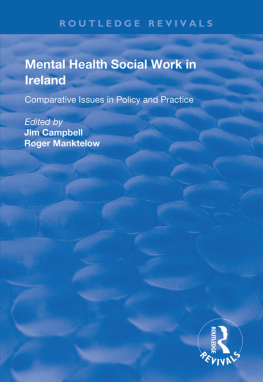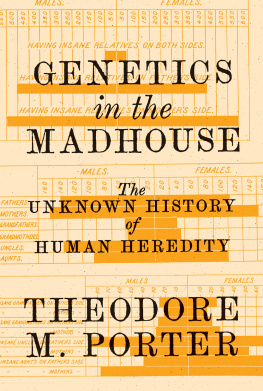Irish Insanity
The national public asylum system in Ireland was established during the early nineteenth century and continued to operate up to the close of the twentieth century. These asylums, or mental hospitals, were a significant physical and social feature of Irish communities. They were used intensively and provided a convenient form of institutional intervention to manage a host of social problems.
Irish Insanity identifies the long-term trends in institutional residency through the development of a detailed empirical data set based on an analysis of original copies of the reports of the Inspector of Asylums/Mental Hospitals in Ireland. Damien Brennan explores core social and historical features linked to this data including:
- the political context
- governance and social policy
- the relationship between church and state
- changing economic structures and social deprivation
- professionalisation
- legislation and systems of admission and discharge
- categorisation and diagnostic criteria
- international developments
- family dynamics.
This book demonstrates that the rate of asylum utilisation in Ireland was the highest by international standards, but challenges the idea that an epidemic of Irish insanity actually existed. Offering a historical and sociological insight into an institutional legacy that is unusual within the international context, it will be of particular relevance and interest to scholars within the fields of sociology, criminology, law, history, Irish studies, social policy, anthropology, nursing and medicine.
Damien Brennan is Assistant Professor in Sociology at the School of Nursing and Midwifery Studies at Trinity College, Dublin.
Irish Insanity
18002000
Damien Brennan
First published 2014
by Routledge
2 Park Square, Milton Park, Abingdon, Oxon OX14 4RN
Simultaneously published in the USA and Canada
by Routledge
711 Third Avenue, New York, NY 10017
Routledge is an imprint of the Taylor & Francis Group, an informa business
2014 Damien Brennan
The right of Damien Brennan to be identified as author of this work has been asserted by him in accordance with sections 77 and 78 of the Copyright, Designs and Patents Act 1988.
All rights reserved. No part of this book may be reprinted or reproduced or utilised in any form or by any electronic, mechanical, or other means, now known or hereafter invented, including photocopying and recording, or in any information storage or retrieval system, without permission in writing from the publishers.
Trademark notice: Product or corporate names may be trademarks or registered trademarks, and are used only for identification and explanation without intent to infringe.
British Library Cataloguing in Publication Data
A catalogue record for this book is available from the British Library
Library of Congress Cataloging in Publication Data
Brennan, Damien (Damien John)
Irish insanity/Damien Brennan.
page cm. (Routledge advances in sociology ; 110)
Includes bibliographical references and index.
1. Mental illnessIrelandHistory. 2. Mentally illCareIrelandHistory.
I. Title.
RC450.I73B74 2013
362.19689009415dc23
2013004021
ISBN: 978-0-415-52225-0 (hbk)
ISBN: 978-0-203-10180-3 (ebk)
Figures
Tables
Appendix: Tables of data
I trained as a psychiatric nurse in a major psychiatric hospital in Dublin and have worked in this capacity both within institutional and community settings. I became a nurse tutor some years ago, have educated nurses to work within the Irish psychiatric services and mental health services, and am now employed as an Assistant Professor at Trinity College in the School of Nursing and Midwifery. I have therefore gained my occupational and financial security within the context of asylum, psychiatric and mental health service provision. The core interest of this book is to critically consider the construction and classification of and responses to madness, insanity and mental illness in Ireland over the past two hundred years. I am particularly concerned with examining the extent and social context of institutional residency during this time. This presents an obvious dilemma, as the concepts, structures and practices that I wish to deconstruct are the ones that I have utilised in developing my career to date.
I am equally aware of a growing acceptance amongst mental health service providers of the need to distance their practice from its roots within the asylum. Academic analysis of the demise of institutional care and the potential for post institutional service provision is increasingly welcomed by mental health professionals. As such, this book further secures my usefulness within this business. Hence, I must acknowledge that I have benefited directly from both the existence and contemporary deconstruction (physical and intellectual) of asylums in Ireland.
The issue of language needs to be addressed from the outset. Terms such as insanity, lunatic, madness, mental illness and mental patient have frequently been utilised in public discourse as phrases which reproduce the experience of stigma and the oppression of individuals perceived as fitting such categories. I use these phrases within this book where necessary as a means of exploring the historical context of their social construction. However, the conceptualisation of such terms as descriptive realities situated within the individual body or mind is challenged.
I am mindful that my previous exposure to, and participation in, psychiatric services provision in Ireland provides both opportunities and limitations in my endeavour to deconstruct the trajectory of Irish insanity and institutional residency. Drawing from and bound by my experiences, I wish to challenge the idea of an epidemic of Irish insanity.
I would like to acknowledge Professor Robert J. Holton, and the wider community at Trinity College Dublin, for providing guidance during the course of conducting the research for this book.
I thank Elaine for her ongoing support and love, and our boys Fionn and Oisin, who make everything worthwhile.
Established in the early nineteenth century, an extensive asylum or mental health system developed in Ireland which was spectacular in both its duration and scale. By the 1950s this system had expanded to such an extent that Ireland had the dubious honour of having the worlds highest rate of asylum residency per 100,000 of population. The existence of this extensive asylum system poses a key biomedical vs. sociological question: did the Irish suffer more insanity than the rest of the global population, or did social forces drive the excessive usage of asylums in Ireland?
This book sets out an empirically based sociological analysis of Irish insanity and asylum usage from 1800 to 2000. It demonstrates that the disproportionately high and prolonged use of asylums in Ireland was driven by the combined impact of various social forces. The existence of a bio-medical epidemic of insanity is therefore disputed and the notion that the Irish have some sort of genetic quirk that exposes them to insanity is rejected. Irish asylums were not sites of caring provided by the state for the better good of large groups of individuals who happened to be afflicted by chronic insanity. In practice these institutions were established, expanded and extensively utilised in response to a wide array of social processes. Rather than being austere and isolated institutions on the margins of communities, asylums were in fact closely intertwined with the fabric of Irish social life at the national, local and individual level. While the act of diagnosis within Irish asylums occurred at the level of the individual patient, in practice medical, social, legal, political and economic contexts influenced both the selection of the insane and institutional responses to insanity.









